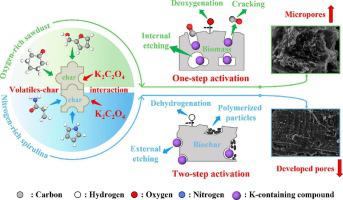Fuel Processing Technology ( IF 7.5 ) Pub Date : 2023-07-29 , DOI: 10.1016/j.fuproc.2023.107926 Jingyi Liang , Chao Li , Kai Sun , Shu Zhang , Shuang Wang , Jun Xiang , Song Hu , Yi Wang , Xun Hu

|
Volatile-char interaction has been well documented in co-pyrolysis of varied feedstocks, which might also exist in activation process and impact pore evolution of activated carbon (AC). This was investigated herein in activation of mixed sawdust and spirulina with K2C2O4 at 800 °C in two scenarios: one-step direct activation or two-step activation with an intermediate pre‑carbonization. The results showed that volatile-char interaction via cross-polymerisation of the volatiles was more significant in the pre‑carbonization step, forming more biochar/bio-oil while less gases. However, volatile-char interaction was not that important in impacting product yields and evolution of pore structures of AC in activation. This was due to the dominance of gasification/cracking with presence of K2C2O4, minimizing the chances for volatile-char interaction. The in-situ DRIFTS characterization of the activation process showed that removal of oxygen-containing species like C O with K2C2O4 was important for generating pore structures. Comparing with two-step activation, one-step activation of sawdust, spirulina and their mixture without pre‑carbonization all generated the ACs of more developed pore structures and showed higher environmental impact. The pre‑carbonization removed a significant portion of thermally unstable aliphatic structures, enhancing aromatic degree and creating difficulty for generating pores via gasification/cracking in subsequent activation.
O with K2C2O4 was important for generating pore structures. Comparing with two-step activation, one-step activation of sawdust, spirulina and their mixture without pre‑carbonization all generated the ACs of more developed pore structures and showed higher environmental impact. The pre‑carbonization removed a significant portion of thermally unstable aliphatic structures, enhancing aromatic degree and creating difficulty for generating pores via gasification/cracking in subsequent activation.
中文翻译:

有或没有预碳化步骤的混合锯末和螺旋藻的活化:探讨挥发物-炭相互作用对热解产物演化的作用
挥发性炭相互作用已在各种原料的共热解中得到充分记录,这种相互作用也可能存在于活化过程中并影响活性炭(AC)的孔隙演化。本文在用 K 2 C 2 O 4活化混合锯末和螺旋藻的过程中对此进行了研究在 800 °C 下,有两种情况:一步直接活化或中间预碳化的两步活化。结果表明,在预碳化步骤中,通过挥发物交叉聚合产生的挥发物与炭的相互作用更为显着,形成更多的生物炭/生物油,同时形成更少的气体。然而,挥发物与炭的相互作用对于影响产品产率和活性炭活化过程中孔结构的演变并不那么重要。这是由于 K 2 C 2 O 4的存在下气化/裂化占主导地位,从而最大限度地减少了挥发物与焦炭相互作用的机会。活化过程的原位 DRIFTS 表征表明, 用 K 2 C 2去除 CO 等含氧物质O 4对于生成孔隙结构很重要。与两步活化相比,未经预碳化的锯末、螺旋藻及其混合物的一步活化均产生了孔隙结构更发达的活性炭,并且表现出更高的环境影响。预碳化去除了很大一部分热不稳定的脂肪族结构,提高了芳香度,并为随后的活化中通过气化/裂解产生孔隙创造了困难。
用 K 2 C 2去除 CO 等含氧物质O 4对于生成孔隙结构很重要。与两步活化相比,未经预碳化的锯末、螺旋藻及其混合物的一步活化均产生了孔隙结构更发达的活性炭,并且表现出更高的环境影响。预碳化去除了很大一部分热不稳定的脂肪族结构,提高了芳香度,并为随后的活化中通过气化/裂解产生孔隙创造了困难。



























 京公网安备 11010802027423号
京公网安备 11010802027423号